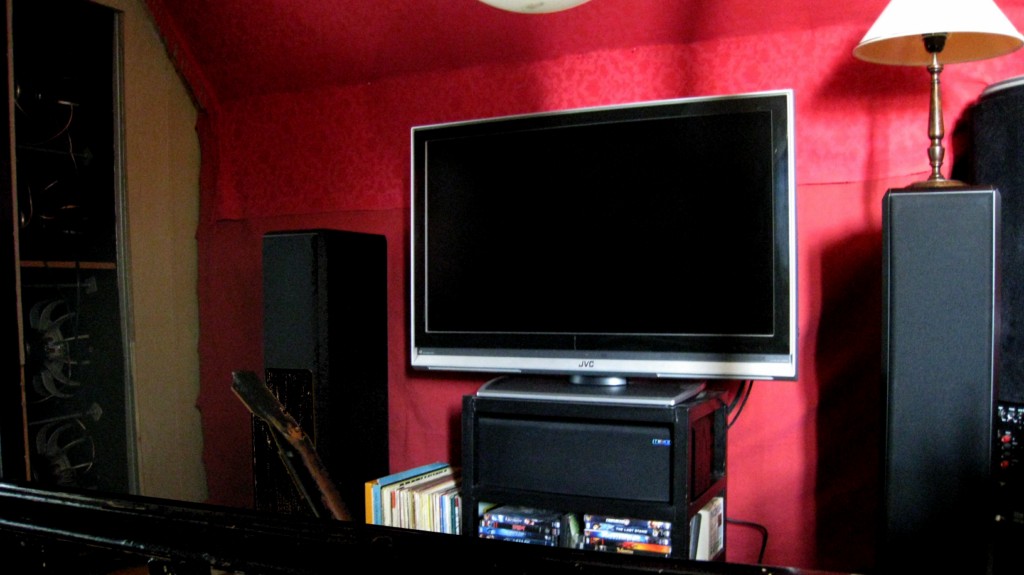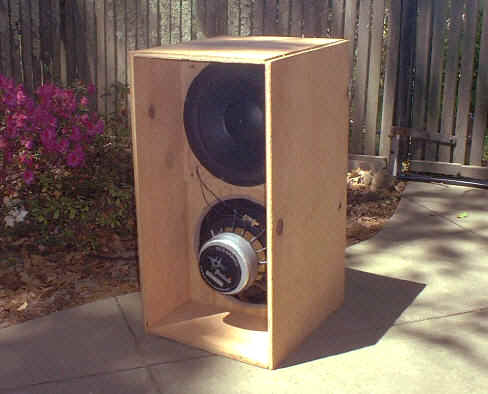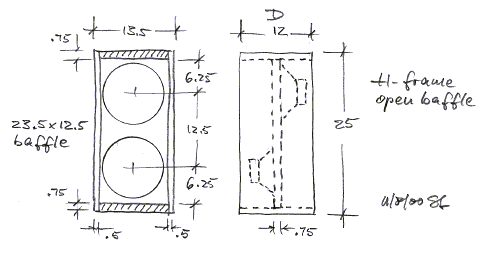|
|
Post by chrisbee on Apr 4, 2012 8:28:02 GMT -7
A 6' x 3' hole in the floor, 4' in front of my chair, robs me of the chance to make a true IB subwoofer in the back of my AV stage. The path length will be only about 5' before cancellation at the nearest edge of the open stairwell. In other words I would be building a 5' x infinite baffle.  My present response has a vast chasm between sub and speakers centred on 140Hz. This is robbing me of much of the impact one would expect from a system with a cone acreage such as mine. Deep bass is already all one could ask for with only four 15" drivers in a half height manifold. Because I am only trying to reinforce the upper bass for more impact I don't need infrasonic response. The four newer AEIB15s provide the deep stuff in great quantity and quality. So the present 16dB boost at 20Hz can be removed from the older drivers. Providing massive headroom and unburstable performance without boost. I have attached an image of a cross section of my stage. A large slot would be made right through the stage floor as far back as possible. To allow a vertical baffle to house the four 15" drivers in a horizontal array. The slot in the ceiling below could be covered by a grill. Or made into a concealed lighting feature when the ceiling is planked over. I have a nagging doubt that I must have missed something obvious in this seemingly simple enhancement of what I already have. Your thoughts would be gratefully received... Attachments:
|
|
|
|
Post by ThomasW on Apr 4, 2012 15:46:37 GMT -7
Can't visualize this from the graphic.
A while back you had a picture of the space including the 1/2 height wall, how about drawing the proposed speaker on the picture?
|
|
|
|
Post by chrisbee on Apr 5, 2012 3:55:45 GMT -7
Hi Thomas I don't have any pictures of the back of the stage. So I have added a label and arrow to indicate the baffle and drivers in cross section right at the back of the stage. They will vent downwards through the stage to exit against the wall in the room below. The knee wall is only a foot high. The ceiling slopes at 45 degrees. The joists run along the room in line with the baffle. I'm thinking the weight of the roof and stiffness of the floor will keep the baffle rock steady in use. The ends of the baffle will be closed off with MDF cut to fit. Attachments:
|
|
|
|
Post by ThomasW on Apr 5, 2012 6:33:19 GMT -7
 Where will this MBM go? |
|
|
|
Post by chrisbee on Apr 5, 2012 6:54:45 GMT -7
Hi Thomas I'd completely forgotten about that picture.  I planned on a horizontal line array. A long baffle resting on the floor about 4' behind the TV. Distance depending on the height of the baffle. To allow the drivers to clear the sloping ceiling and knee wall. The baffle will be vertical of course. A large slot behind the baffle will pass right through the stage floor to the room below. Can't photograph the area without removing a load of boxed storage first. Which will give the game away!  |
|
|
|
Post by FOH on Apr 5, 2012 8:03:51 GMT -7
What are your primary concerns? I don't understand the entire question  |
|
|
|
Post by ThomasW on Apr 5, 2012 9:38:37 GMT -7
IIRC, his room is acoustical nightmare.
There's a stairwell opening between the listening position and the speakers. On two or 3 sides of the opening is a safety wall so people don't accidentally step in the hole.
Naturally the stairway hole and wall obstruct/absorb the sound from the mains.
He's attempting to use his extra speakers to make a MBM and hopes it will send more midbass to the listening position. Problem is you can't fool father physics. Having more drivers doesn't mean the sound is going to make it to the listener given the issues with the room.
As a quick and dirty experiment he could fabricate a simple open baffle with the extra 15"s. Hang it in the intended location and see what happens. Doing that will require another crossover section and added amp.
|
|
|
|
Post by chrisbee on Apr 5, 2012 14:09:07 GMT -7
You are right about the hole in the floor. There is no wall though. There is a wooden handrail and slender, well spaced balusters on the nearside only. Which the sound passes right though completely without hindrance.
I am trying to fill a deep chasm in the response centred on 140Hz. This grand canyon is caused by the distance between the IB, in the left wall and the right speaker.
I have four IB15s available to fill this trough. I will drive them with one channel of the EP2500 using the variable CX2310 crossover potential on that channel. Just as they are now. But moved out of the 6' tall manifold into a horizontal array between the main speakers. The hole in the floor will limit the baffle size to about 5'.
The crux of the matter is whether there is some unknown acoustic disaster about to befall such an odd arrangement?
The baffle will form a triangular cross section chamber. With a large hole in the bottom. So there will be a different acoustic path length between the front and rear of the drivers. As per the drawings.
Manifolds might colour the upper bass more than a semi-open baffle if I push the crossover point upwards.
Either option involves some woodwork and considerable disturbance. So I thought I'd run my hair-brained scheme past the experts first.
|
|
|
|
Post by severianb on Apr 5, 2012 14:23:04 GMT -7
It would make sense to rig up (as ThomasW suggested) or buy a cheap sub to test your placement before building... since your room is basically impossible to model. Maybe Harmon or Bose could do it, but I bet you'd have to pay them more than the price of a cheap subwoofer.
You are just guessing right now. Test with a temporary sub first. That's the ONLY way to be sure.
|
|
|
|
Post by ThomasW on Apr 5, 2012 16:30:42 GMT -7
140Hz ~2.4m wavelength.
Isn't that the distance between the speakers and the hole in the floor?
Try this....
Go to the shed, grab a piece of wood and mount the drivers as an open baffle. Suspend the baffle between the mains behind the TV.
Now what happens to the 140Hz null? If it's still there there's no point in building what you propose. If the null is gone build away....
|
|
|
|
Post by chrisbee on Apr 5, 2012 23:50:54 GMT -7
Thanks for your continued responses. Unfortunately it isn't as easy as that, Thomas. I made some small test baffles to go on the stage but the rattles were louder than the music! Though I clamped the baffles firmly to the steel TV stand the vibrations were still fierce. Much more impact but the noise and SQ were not an improvement. So I built some compact, opposed-driver manifolds. These boxes were placed, open side down, on the floor of the stage. Pushed as far back as possible. So they were acting as grossly undersized, sealed boxes. They were very inefficient. After a considerable level increase, there was much more impact. The sound quality, however, was absolutely dire! So I returned the test drivers to the tall IB manifold. My real problem is not knowing how opening up the back of the stage floor would affect the response. Or the overall sound quality. This rear venting would be vital. To make the system into a "proper" open baffle of maximum possible dimensions. I can't just let a four x 15" baffle "leak" out of the open ends on the stage. Ideally the baffle should be sealed at the ends and all around the perimeter. All of the cyclic air movement, at the rear of the baffle, should take place down through the opening in the stage floor. This ensures the driver's rear output remains phase coherent. The maximum acoustic path length is also obtained before cancellation occurs at the edge of the open stairwell. But! If the experiment fails, after removing the downstairs ceiling, it would be a domestic disaster!  |
|
|
|
Post by severianb on Apr 6, 2012 4:12:34 GMT -7
I don't see how the testing I (and others) did by placing a test subwoofer where the floor manifold hole would be, is any different than what you have already done with your test subwoofer(s). The fact that you are putting a hole in the floor to vent the backwave has absolutely no bearing on the in-room response vs. your test subwoofers. The only difference being the quality of sound. Sounds to me like you have already tested it (you got MLP reponse graphs, I assume) and it didn't work.  Oh, and another important question, did you run your current IB and test subwoofer at the same time? |
|
|
|
Post by chrisbee on Apr 6, 2012 4:33:40 GMT -7
Hi
It worked as far as response went but the sound quality was awful. Hardly surprising given the choice of test subs but still disappointing.
I ran a half-sized IB and the main speakers simultaneously since I wanted to eliminate the combined cancellation trough with these drivers.
I had an even crazier idea that leaves the downstairs ceiling unsullied. I use the stage volume as the return path for the rear wave. Port the rear of the stage floor as planned. Then leave the front edge of the stage completely open. With a suitable grill covering, of course.
The stage has a strange construction. Two lots of joists running parallel with spacers in between. I didn't build the stage and it isn't truly load bearing. It came with the house.
I expect the stage would just act as a tuned port and ruin the sound of the baffle alignment. There just isn't enough cross sectional area to avoid a tuned port effect. The labyrinth would act resistively on the drivers. Better not follow that path. ;D
|
|
|
|
Post by severianb on Apr 6, 2012 6:57:04 GMT -7
Hi It worked as far as response went but the sound quality was awful. Hardly surprising given the choice of test subs but still disappointing. I must be missing something, because it sounds like you have answered your own question. Just build it.  |
|
|
|
Post by ThomasW on Apr 6, 2012 7:03:49 GMT -7
So I built some compact, opposed-driver manifolds. These boxes were placed, open side down, on the floor of the stage. Pushed as far back as possible. So they were acting as grossly undersized, sealed boxes. They were very inefficient. After a considerable level increase, there was much more impact. The sound quality, however, was absolutely dire! So I returned the test drivers to the tall IB manifold. This was a "no go" from the beginning. The Vas of the AE drivers means they need an IB or OB, nothing else will work   Yes it would and that's one reason why what you propose isn't very realistic. I would try a pair of "H-frame" dipole woofer boxes each with 2 drivers. Here's what the design looks like.   The length of the sides (distance 'D') determines the low frequency cut off point. Face both drivers forward if they're going to be running 140Hz or higher. |
|
|
|
Post by chrisbee on Apr 6, 2012 7:36:36 GMT -7
Thanks again, gentlemen. I'm not sure why you don't like or perhaps understand (?) my use of as large an open baffle as possible, Thomas. Most open baffles stand up relative to the listener. My baffle is lying down. The baffle is the stage itself. The drivers sit in a sub baffle at the rear of the stage. The sub baffle is sealed to the ceiling and floor just like any other manifold. This sealing ensures the front of the cone is isolated from the back. The rear wave must pass through the floor slot to reach the front wave. The two pressure waves will eventually meet and cancel at the front edge of the stage. (via the open stairwell) Exactly the same effect would occur if I fitted manifolds over holes in the back of the stage floor. Except I'm hoping that a baffle should provide better SQ. Since my proposed manifold becomes a horizontal line array. With a triangular cross section devoid of parallel panels. Let's say you tipped up my design by 90 degrees: My stage becomes a wall. Now my design is a perfectly normal, wall mounted, IB, vertical array. It is not a true IB because it is installed only 5' from a 6'x 3' door opening. That "door opening" is my open stairwell. Does this make any sense?  |
|
|
|
Post by ThomasW on Apr 6, 2012 8:07:20 GMT -7
. Does this make any sense?  I understand what you propose. You've been trying to integrate aspects of the house construction into the audio system since day one. Thing is it's overcomplicated and probably won't provide any sonic benefit over a simple H-frame dipole. |
|
|
|
Post by chrisbee on Apr 6, 2012 8:07:37 GMT -7
Another drawing. Attachments:
|
|
|
|
Post by chrisbee on Apr 6, 2012 8:11:45 GMT -7
Thomas
Sorry, but the H-frame dipoles are just too big for my cramped stage with a couple of 15"s per box.
|
|
|
|
Post by ThomasW on Apr 6, 2012 8:45:02 GMT -7
Obviously you can build it, but why?
IIRC the room/structure is already acoustically 'lossy' since none of the cottage structure is inherently stiff. Cutting more holes in the floor at the wall junction will just make things even more flexible
Appears that there's plenty of room to place H-frames behind the TV and in front of the rearwall. Turn them on edge and 'fly' them from the ceiling if you want a horizontal look. Actually 4 individual dipole boxes might be aesthetically interesting, and give you greater control over 'aiming' the array
With dipoles you'll get cancellation at the baffle edges. That's a plus since dipoles tend to make the rearwall 'disappear' from an acoustical standpoint.
Is there any empty space behind the listening position?
BTW from the looks of your drawing you might go to a higher SPF rating for your sunscreen .......... ;D
|
|